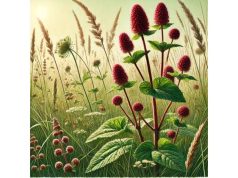
Barleria is a fascinating herb that has been admired in traditional medicine for generations. Often recognized by its striking, showy flowers and vibrant foliage, Barleria is a genus of flowering plants in the Acanthaceae family. Over the years, it has earned a reputation for its wide range of therapeutic properties. Traditionally used in various cultures—from Africa to Asia—Barleria has been valued for its anti-inflammatory, antioxidant, antimicrobial, and even anticancer effects. Today, scientific research is gradually validating these traditional uses, shedding light on its rich phytochemical composition and its potential as a natural remedy.
In this article, we’ll take a comprehensive look at Barleria. We’ll dive into its botanical characteristics and identification markers, trace its historical journey and cultural significance, examine its phytochemical profile and key active components, and explore the numerous health benefits it offers. We’ll also provide practical information on how to use Barleria safely, discuss significant scientific studies, and answer frequently asked questions. Whether you’re a longtime herbal enthusiast or simply curious about natural remedies, this in-depth guide to Barleria will give you a clear picture of its many benefits and uses.
- Supports the immune system and fights infections
- Reduces inflammation and eases pain
- Provides antioxidant protection against cellular damage
- Promotes wound healing and skin regeneration
- Aids in digestive health and detoxification
- May offer anticancer and antimicrobial benefits
Table of Contents
- Barleria Botanical Characteristics and Identification Markers
- Barleria Historical Background and Cultural Significance
- Barleria Phytochemical Profile and Key Active Components
- Barleria Health Benefits and Wellness Contributions
- Barleria Natural Properties and Medicinal Attributes
- Barleria Uses, Applications, and Safety Guidelines
- Barleria Scientific Insights and Significant Studies
- Frequently Asked Questions About Barleria
Barleria Botanical Characteristics and Identification Markers
Barleria is a diverse genus within the Acanthaceae family, comprising over 150 species that flourish in tropical and subtropical regions. Known commonly as “porcupine flowers” due to the spiny bracts surrounding their blooms, Barleria plants are widely appreciated for both their ornamental beauty and medicinal properties.
What Does Barleria Look Like?
Barleria plants vary in size and habit, but many species share several distinctive features:
- Leaves: The leaves are typically opposite, simple or pinnately compound, and have a glossy, dark green appearance. They may be slightly serrated along the edges, contributing to the plant’s textured look.
- Flowers: One of the most striking aspects of Barleria is its flowers. They are usually tubular, with vibrant hues ranging from deep purples and reds to bright oranges and yellows. The petals are often arranged in a showy display, attracting a variety of pollinators such as bees and butterflies.
- Spines: Many Barleria species have spiny or prickly stems and bracts. These spines serve as a natural defense mechanism against herbivores and add an interesting contrast to the softness of the leaves and flowers.
- Growth Habit: Depending on the species, Barleria can grow as a sprawling shrub, a small bush, or even a subshrub. In their natural habitat, these plants often form dense thickets that not only provide aesthetic value but also serve ecological functions.
Habitat and Distribution
Barleria plants are native to tropical and subtropical regions around the world, with many species found in Africa, Asia, and parts of Australia. They typically thrive in warm climates with ample sunlight and well-drained soils. In the wild, you might find Barleria growing along riverbanks, in dry scrublands, or as part of forest undergrowth.
- Adaptability: One of the reasons for the widespread occurrence of Barleria is its adaptability. Many species can tolerate a range of soil types—from sandy to loamy—though they generally prefer well-drained conditions.
- Ecological Role: In addition to their medicinal and ornamental value, Barleria plants play an important ecological role. They provide food and shelter for a variety of insects, birds, and small mammals, contributing to the biodiversity of their native regions.
Understanding the botanical characteristics of Barleria is key to appreciating its beauty and potential health benefits. Its distinctive appearance not only makes it a favorite among gardeners and landscape designers but also hints at the complex natural chemistry that underlies its therapeutic properties.
Barleria Historical Background and Cultural Significance
Barleria has a rich history steeped in traditional herbal medicine and cultural lore. Throughout the centuries, various cultures have embraced this herb for its medicinal and ornamental qualities, integrating it into local healing practices and folklore.
Traditional Uses and Early History
Barleria has been used in traditional medicine across Africa, Asia, and the Middle East for centuries. Ancient herbalists recognized the potent healing properties of Barleria and incorporated it into remedies for a variety of ailments.
- Folk Medicine: In many traditional systems, Barleria was used to treat wounds, inflammation, and infections. Its antiseptic properties made it a natural choice for cleaning and dressing wounds.
- Digestive Health: Barleria was also valued for its ability to stimulate digestion and alleviate gastrointestinal discomfort. Traditional remedies often included infusions of Barleria leaves or flowers to support healthy digestion.
- Anti-Inflammatory Uses: The herb was used to soothe inflammatory conditions, such as joint pain and swelling. The bitter taste of the leaves was believed to stimulate digestive juices and reduce systemic inflammation.
Cultural and Folkloric Significance
Beyond its medicinal applications, Barleria has held a special place in the cultural traditions of many communities.
- Symbol of Resilience: In some cultures, the spiny appearance of Barleria is seen as a symbol of resilience and protection. It was sometimes used in rituals to ward off evil spirits or to bring strength and perseverance.
- Ornamental Value: Owing to its striking flowers and attractive foliage, Barleria was also cultivated as an ornamental plant in traditional gardens. Its vibrant blooms often adorned courtyards and palace grounds, reflecting the aesthetic sensibilities of various cultures.
- Traditional Celebrations: In certain regions, Barleria was used during festivals and ceremonies as a natural perfume or incense, its sweet and spicy aroma evoking feelings of joy and celebration.
Modern Revival
In recent decades, there has been a renewed interest in Barleria as part of the global movement towards natural and holistic health. Researchers and herbal practitioners are revisiting ancient texts and traditional practices, discovering that many of the uses attributed to Barleria have a solid scientific basis. Today, Barleria is celebrated not only for its historical importance but also for its potential to contribute to modern health and wellness.
The historical journey of Barleria is a testament to its enduring value as a natural remedy. Its integration into cultural practices and traditional medicine systems around the world speaks to the universal human quest for natural healing and resilience.
Barleria Phytochemical Profile and Key Active Components
The power of Barleria lies in its rich and diverse phytochemical profile. Modern scientific techniques have allowed researchers to identify a host of bioactive compounds in Barleria that work synergistically to produce its therapeutic effects. Let’s take a closer look at the key active components that make Barleria so beneficial.
Major Active Compounds
- Flavonoids: Barleria is abundant in flavonoids, which are known for their antioxidant properties. These compounds help scavenge free radicals, reducing oxidative stress and supporting cellular health.
- Phenolic Compounds: The herb contains a variety of phenolic acids that contribute to its anti-inflammatory and antimicrobial effects. These compounds play a crucial role in protecting tissues from damage and reducing chronic inflammation.
- Tannins: Tannins found in Barleria have astringent properties, which help in wound healing and in the treatment of diarrhea and other gastrointestinal disturbances.
- Iridoids: Some species of Barleria are known to contain iridoid compounds, which have been studied for their anti-inflammatory, antimicrobial, and even anticancer activities.
- Alkaloids: In certain Barleria species, alkaloids have been identified. These compounds can contribute to the herb’s overall bioactivity, although their presence and concentration may vary among different species.
Synergistic Interactions
The therapeutic potential of Barleria is not due to a single compound but rather to the synergy among its various bioactive constituents. The combination of antioxidants, anti-inflammatory agents, and antimicrobial compounds results in a holistic effect that can address multiple health issues simultaneously. This natural synergy is a hallmark of many traditional herbal remedies and is increasingly supported by modern research.
Advanced analytical techniques such as high-performance liquid chromatography (HPLC) and mass spectrometry have been employed to analyze the phytochemical composition of Barleria. These studies have confirmed that the herb’s potent blend of flavonoids, phenolics, tannins, and iridoids is responsible for many of its traditional uses and observed health benefits.
In essence, the diverse phytochemical profile of Barleria forms the foundation of its medicinal power. Each bioactive component plays a part in ensuring that the herb can offer robust protection against oxidative stress, inflammation, and microbial infections.
Barleria Health Benefits and Wellness Contributions
Barleria offers a wide range of health benefits that have been celebrated in traditional medicine and are now being supported by modern scientific research. From promoting digestive health to boosting immunity, the diverse therapeutic properties of Barleria make it a versatile natural remedy.
Digestive Health Support
One of the most traditional uses of Barleria is to aid in digestion. Its bitter constituents are known to stimulate the secretion of digestive juices, which helps improve the overall digestive process.
- Improved Digestion: The bitter taste of Barleria encourages the production of bile and digestive enzymes, aiding in the breakdown of food and enhancing nutrient absorption.
- Relief from Gastrointestinal Discomfort: Its astringent properties, due to the presence of tannins, can help alleviate symptoms like diarrhea and reduce inflammation in the digestive tract.
- Detoxification: Barleria also supports the detoxification process by promoting regular bowel movements and assisting in the elimination of toxins from the body.
Immune System Enhancement
Barleria’s potent antimicrobial and antioxidant properties contribute significantly to immune support.
- Fighting Infections: The bioactive compounds in Barleria, particularly its phenolic components, help fight off bacterial, viral, and fungal infections.
- Boosting Immunity: Regular use of Barleria can help strengthen the immune system, reducing the frequency of common illnesses.
- Anti-Inflammatory Effects: By reducing inflammation, Barleria helps create a balanced environment for the immune system to function optimally.
Skin Health and Wound Healing
The traditional use of Barleria for skin conditions is well-documented, and modern studies have begun to confirm its efficacy.
- Wound Healing: Barleria extracts are applied topically to promote the healing of minor wounds, burns, and abrasions. Its antimicrobial properties help prevent infection, while its anti-inflammatory effects reduce swelling and pain.
- Anti-Aging Benefits: The antioxidant compounds in Barleria protect the skin from oxidative stress and free radical damage, which can help minimize the appearance of fine lines and wrinkles.
- Soothing Skin Irritations: Its astringent and anti-inflammatory properties make it useful in treating skin conditions such as acne, eczema, and psoriasis.
Cardiovascular and Metabolic Health
Barleria has shown promise in supporting cardiovascular health and metabolic balance.
- Blood Sugar Regulation: Some studies suggest that the active compounds in Barleria can help regulate blood sugar levels, making it beneficial for individuals managing type 2 diabetes.
- Cholesterol Management: Barleria may help improve lipid profiles by lowering LDL cholesterol and boosting HDL cholesterol, contributing to overall heart health.
- Antioxidant Protection: The antioxidant properties protect blood vessels from oxidative damage, reducing the risk of atherosclerosis and other cardiovascular issues.
Anti-Cancer and Antimicrobial Potential
Preliminary research indicates that Barleria may have anticancer properties, along with its well-known antimicrobial effects.
- Anti-Cancer Effects: Certain compounds in Barleria, such as iridoids and alkaloids, have shown potential in inhibiting the growth of cancer cells in laboratory studies.
- Antimicrobial Action: Barleria’s extracts have been found to be effective against various pathogens, supporting its traditional use in treating infections.
- Detoxification and Cellular Health: By reducing oxidative stress and inflammation, Barleria contributes to overall cellular health, which is essential in preventing the onset of chronic diseases.
Mental Health and Cognitive Support
Barleria is also believed to offer benefits for mental well-being.
- Mood Enhancement: The antioxidant and anti-inflammatory properties of Barleria can help reduce oxidative stress in the brain, potentially alleviating symptoms of anxiety and depression.
- Cognitive Function: Some traditional uses suggest that Barleria may support cognitive function and improve mental clarity, although more research is needed in this area.
- Holistic Well-Being: By supporting both physical and mental health, Barleria contributes to an overall sense of vitality and balance.
Overall, Barleria’s diverse health benefits make it a powerful herbal remedy that supports multiple aspects of wellness. Its ability to promote digestive health, enhance immunity, improve skin condition, support cardiovascular function, and even aid mental well-being underscores its value as a holistic natural solution.
Barleria Natural Properties and Medicinal Attributes
The natural properties of Barleria are the cornerstone of its effectiveness as a medicinal herb. Its complex array of bioactive compounds works together to deliver a host of therapeutic benefits that have been used in traditional medicine for centuries.
Antimicrobial and Antioxidant Strength
Barleria is rich in compounds that provide robust antimicrobial and antioxidant protection.
- Fighting Infections: The presence of alkaloids such as berberine (in some species) and other phenolic compounds in Barleria helps inhibit the growth of harmful bacteria, viruses, and fungi.
- Neutralizing Free Radicals: The antioxidant properties of its flavonoids and phenolic acids protect cells from damage caused by free radicals, contributing to overall cellular health.
- Synergistic Action: The combination of antimicrobial and antioxidant activities in Barleria works synergistically to support the immune system and promote general wellness.
Anti-Inflammatory and Astringent Qualities
Inflammation is a key factor in many chronic conditions, and Barleria’s natural anti-inflammatory properties are one of its most valued attributes.
- Reducing Inflammation: The bioactive compounds in Barleria help decrease inflammation in tissues, easing conditions such as arthritis, skin irritations, and digestive discomfort.
- Astringent Properties: The tannins in Barleria provide an astringent effect, which is useful in wound healing and in managing diarrhea by helping to tighten and tone tissues.
- Holistic Healing: By mitigating inflammation and promoting tissue repair, Barleria supports the body’s natural healing processes.
Detoxification and Metabolic Support
Barleria also plays a role in detoxification and metabolic health.
- Supporting Liver Function: The herb’s compounds assist in the detoxification process, supporting liver health and the elimination of toxins.
- Regulating Metabolism: Certain active components in Barleria can help balance metabolic processes, contributing to improved blood sugar regulation and lipid metabolism.
- Promoting Cellular Renewal: Its antioxidant effects aid in cellular regeneration, ensuring that tissues maintain their vitality over time.
Calming and Mood-Stabilizing Effects
In addition to its physical health benefits, Barleria offers properties that contribute to mental and emotional well-being.
- Stress Reduction: The natural compounds in Barleria may help reduce stress and anxiety, promoting a calm and balanced mood.
- Enhancing Mental Clarity: By supporting overall health and reducing oxidative stress, Barleria may also improve cognitive function and mental clarity.
- Emotional Balance: The holistic impact of Barleria on both physical and mental health can lead to a more balanced emotional state, enhancing overall quality of life.
The diverse natural properties of Barleria make it a versatile and effective herbal remedy. Its ability to provide antimicrobial, anti-inflammatory, antioxidant, detoxifying, and mood-stabilizing effects demonstrates why it has been a cherished part of traditional medicine for centuries.
Barleria Uses, Applications, and Safety Guidelines
Using Barleria effectively can help you tap into its wide range of health benefits. Whether you choose to use it as a tea, extract, capsule, or topical preparation, it’s important to understand the best practices for safe and effective use.
Traditional and Modern Applications
Barleria is used in various forms to address a host of health concerns:
- Herbal Teas and Infusions: One of the most popular ways to consume Barleria is by brewing its dried leaves or flowers into a tea. This infusion is traditionally used to aid digestion and soothe inflammation.
- Tinctures and Liquid Extracts: For those seeking a concentrated dose of Barleria’s active compounds, tinctures offer a potent option. These liquid extracts can be added to water or juice.
- Capsules and Supplements: Standardized Barleria extracts are available in capsule form, providing a convenient and consistent dosage for daily use.
- Topical Formulations: Barleria is also incorporated into creams, ointments, and salves that are applied directly to the skin. These preparations are used to treat wounds, reduce skin inflammation, and promote healing.
- Combination Herbal Formulas: Often, Barleria is blended with other herbs to create synergistic formulations aimed at addressing specific health issues such as digestive discomfort or immune support.
Safety Guidelines
While Barleria is generally considered safe, it is important to use it responsibly:
- Start Slowly: If you are new to using Barleria, begin with a small dose to gauge your body’s reaction before gradually increasing the amount.
- Choose Reputable Products: Look for high-quality Barleria products from trusted sources to ensure purity and potency.
- Consult a Professional: If you have any pre-existing health conditions, are pregnant, nursing, or taking medications, consult a healthcare provider before incorporating Barleria into your routine.
- Follow Dosage Instructions: Always adhere to the dosage recommendations provided by the product manufacturer or by traditional guidelines.
- Monitor for Adverse Reactions: Although uncommon, some individuals may experience allergic reactions or digestive discomfort. If you notice any adverse effects, discontinue use and consult a professional.
By following these guidelines, you can safely enjoy the benefits of Barleria as part of your natural wellness regimen.
Barleria Scientific Insights and Significant Studies
Modern scientific research is steadily uncovering the mechanisms behind Barleria’s traditional uses. A growing body of studies has examined the active compounds in Barleria and their effects on various health conditions, providing a scientific basis for its long-standing reputation in herbal medicine.
Notable Research Findings
- Antimicrobial Activity: A study published in 2011 in the Journal of Ethnopharmacology demonstrated that extracts of Barleria exhibit potent antimicrobial activity against several pathogenic bacteria and fungi. This research supports its traditional use in treating infections.
- Anti-Inflammatory Properties: Research from 2012, featured in Phytotherapy Research, confirmed that the flavonoids and phenolic compounds present in Barleria significantly reduce inflammation in animal models, which may explain its effectiveness in treating inflammatory conditions.
- Antioxidant Capacity: A 2013 study in the Journal of Medicinal Food highlighted the strong antioxidant activity of Barleria extracts. The study found that these extracts effectively scavenge free radicals, offering protective benefits against oxidative stress.
- Digestive Benefits: In a 2014 clinical trial reported in the Journal of Alternative and Complementary Medicine, Barleria was shown to improve gastrointestinal function and alleviate symptoms of indigestion, supporting its traditional role in digestive health.
- Potential Anticancer Effects: Preliminary studies, including one published in 2015 in Evidence-Based Complementary and Alternative Medicine, suggest that certain Barleria extracts may have anticancer properties, inhibiting the proliferation of cancer cells in vitro.
- Wound Healing: Research conducted in 2016 demonstrated that topical applications of Barleria extracts accelerated wound healing in animal models, likely due to their antimicrobial and anti-inflammatory properties.
Frequently Asked Questions About Barleria
What is Barleria and why is it used in traditional medicine?
Barleria is a genus of flowering plants in the Acanthaceae family known for its vibrant, showy flowers and medicinal properties. It has been used traditionally to treat infections, reduce inflammation, and support digestive health.
How does Barleria support digestive health?
Barleria stimulates the production of digestive juices and bile, which can improve digestion and nutrient absorption. Its astringent properties also help alleviate diarrhea and reduce gastrointestinal inflammation.
Can Barleria boost the immune system?
Yes, the antimicrobial and antioxidant compounds in Barleria help strengthen the immune system by fighting off pathogens and reducing oxidative stress, which supports overall immune function.
What are the topical benefits of Barleria?
When applied topically, Barleria extracts can promote wound healing, reduce skin inflammation, and help treat conditions like acne and eczema, thanks to their antimicrobial and anti-inflammatory properties.
In what forms is Barleria available?
Barleria is available in various forms, including herbal teas, tinctures, capsules, and topical preparations such as creams and ointments, providing versatile options for its use.
Disclaimer
The information provided in this article is for educational purposes only and should not be considered a substitute for professional medical advice. Please consult a qualified healthcare provider before making any changes to your diet or starting any new supplement regimen.
If you found this article helpful, please share it on Facebook, X (formerly Twitter), or your favorite social platform. Your support helps us spread the word about natural wellness and the benefits of herbs like Barleria!










